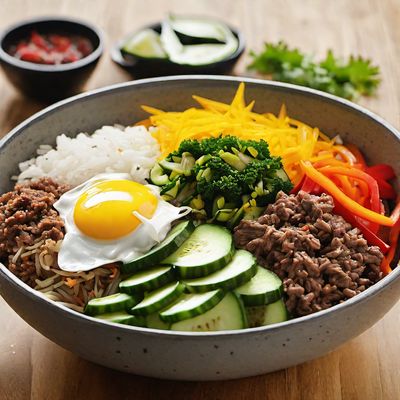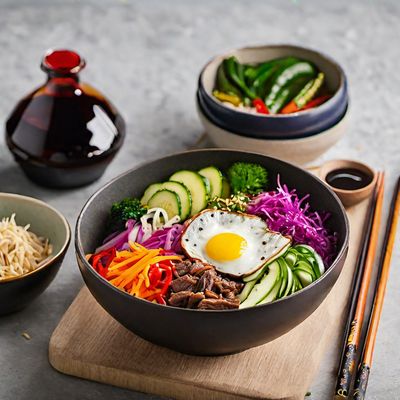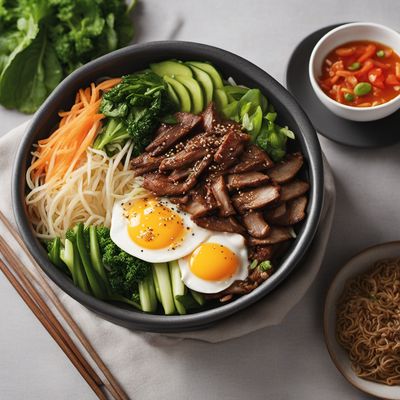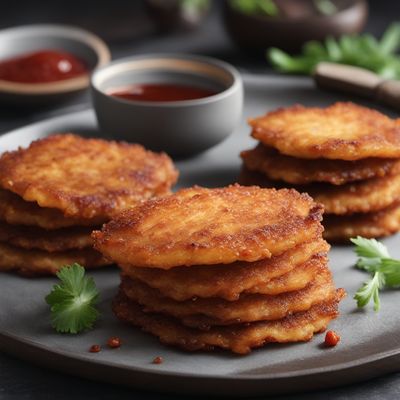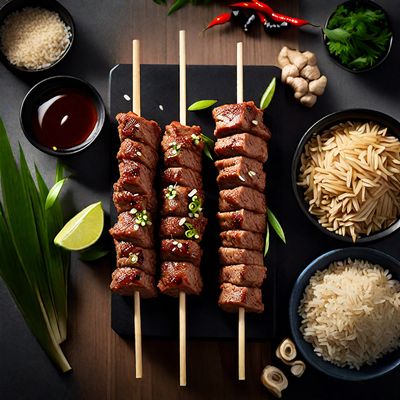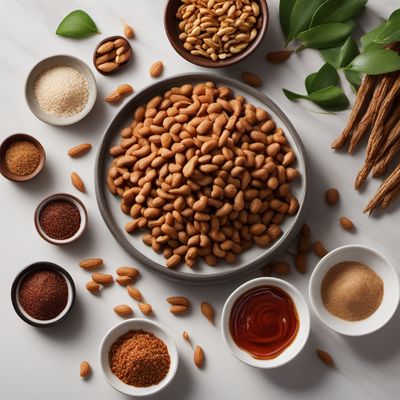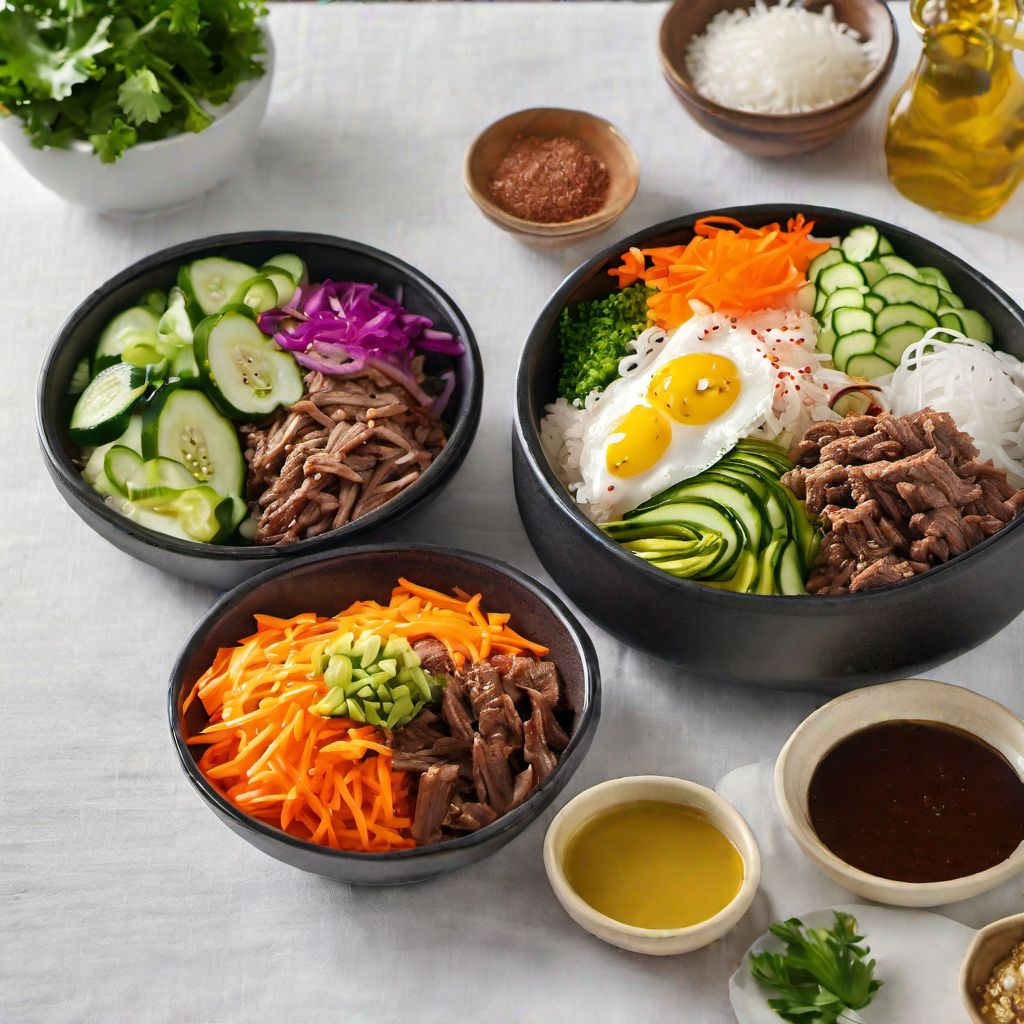
Recipe
Bavarian Bibimbap
Bavarian Fusion Bowl: A Twist on Traditional Bibimbap
4.7 out of 5
In the heart of Bavaria, we bring you a delightful fusion of Korean and Bavarian cuisines. Bavarian Bibimbap combines the vibrant flavors of Korea with the hearty ingredients of Bavaria. This dish is a harmonious blend of textures and tastes, perfect for those seeking a unique culinary experience.
Metadata
Preparation time
30 minutes
Cooking time
20 minutes
Total time
50 minutes
Yields
4 servings
Preparation difficulty
Medium
Suitable for
Omnivore, Gluten-free, Dairy-free, Nut-free, Low sugar
Allergens
Mustard, Eggs, Wheat (if using regular soy sauce)
Not suitable for
Vegan, Vegetarian, Paleo, Keto, High protein
Ingredients
While the original Bibimbap is traditionally made with Korean ingredients like gochujang and kimchi, our Bavarian adaptation incorporates local Bavarian flavors. We substitute the traditional Korean vegetables with Bavarian vegetables like sauerkraut and pickled cucumbers. Additionally, we replace the Korean chili paste with a tangy Bavarian mustard sauce to add a distinct flavor profile. We alse have the original recipe for Bibimbap, so you can check it out.
-
2 cups (470ml) cooked rice 2 cups (470ml) cooked rice
-
200g (7oz) beef, thinly sliced 200g (7oz) beef, thinly sliced
-
1 tablespoon vegetable oil 1 tablespoon vegetable oil
-
1 onion, thinly sliced 1 onion, thinly sliced
-
1 carrot, julienned 1 carrot, julienned
-
1 zucchini, julienned 1 zucchini, julienned
-
100g (3.5oz) sauerkraut 100g (3.5oz) sauerkraut
-
100g (3.5oz) pickled cucumbers 100g (3.5oz) pickled cucumbers
-
4 eggs 4 eggs
-
Bavarian mustard sauce, to taste Bavarian mustard sauce, to taste
-
Salt and pepper, to taste Salt and pepper, to taste
Nutrition
- Calories (kcal / KJ): 450 kcal / 1884 KJ
- Fat (total, saturated): 12g, 3g
- Carbohydrates (total, sugars): 60g, 5g
- Protein: 25g
- Fiber: 6g
- Salt: 2g
Preparation
-
1.Heat the vegetable oil in a pan over medium heat. Add the sliced onion and cook until translucent.
-
2.Add the beef to the pan and cook until browned. Season with salt and pepper to taste.
-
3.In a separate pan, sauté the carrot and zucchini until tender.
-
4.Fry the eggs sunny-side up or to your desired doneness.
-
5.Divide the cooked rice into serving bowls.
-
6.Arrange the sautéed vegetables, sauerkraut, pickled cucumbers, and beef on top of the rice.
-
7.Place a fried egg on each bowl.
-
8.Drizzle Bavarian mustard sauce over the ingredients.
-
9.Serve hot and mix all the ingredients together before eating.
Treat your ingredients with care...
- Beef — For a tender and flavorful result, marinate the beef in a mixture of soy sauce, garlic, and ginger for at least 30 minutes before cooking.
- Bavarian mustard sauce — Adjust the amount of mustard sauce according to your preference for spiciness. Add more for a bolder flavor or less for a milder taste.
- Pickled cucumbers — If you can't find Bavarian pickled cucumbers, you can substitute them with regular pickles or gherkins.
Tips & Tricks
- To add a Bavarian twist, you can sprinkle some crispy fried onions on top of the Bibimbap for extra flavor and texture.
- Feel free to customize your Bavarian Bibimbap by adding other Bavarian ingredients such as sliced sausages or roasted mushrooms.
- If you prefer a vegetarian version, you can omit the beef and add tofu or tempeh as a protein substitute.
- Experiment with different types of rice, such as brown rice or wild rice, for a healthier alternative.
- Don't forget to mix all the ingredients together thoroughly before eating to fully enjoy the flavors and textures of this dish.
Serving advice
Serve the Bavarian Bibimbap hot, straight from the pan. Encourage your guests to mix all the ingredients together to create a harmonious blend of flavors. Garnish with fresh herbs like parsley or chives for a pop of color.
Presentation advice
Present the Bavarian Bibimbap in individual bowls, showcasing the vibrant colors of the ingredients. Arrange the sautéed vegetables, sauerkraut, pickled cucumbers, and beef in an appealing pattern on top of the rice. Place the fried egg on the center and drizzle the Bavarian mustard sauce over the dish for an enticing presentation.
More recipes...
For Bibimbap » Browse all
For Korean cuisine » Browse all
More Korean cuisine dishes » Browse all
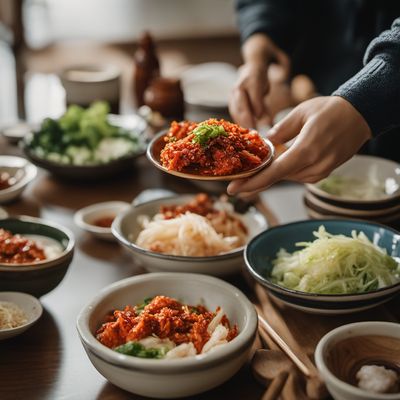
Baek kimchi
Baek kimchi is a traditional Korean dish that is made by pickling napa cabbage in a mixture of salt, garlic, ginger, and chili flakes.
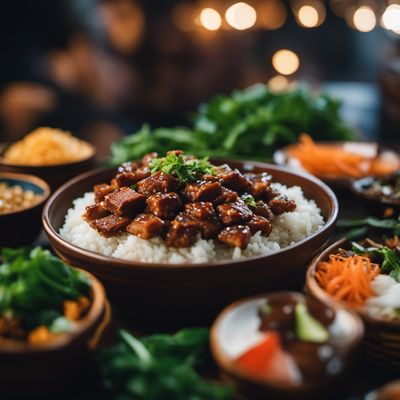
Sunga Pork
Sunga Pork is a traditional Filipino dish that is known for its sweet and savory flavor. The dish is made with pork that is marinated in a mixture...

Chamchi gimbap
Tuna gimbap
Chamchi gimbap is a type of Korean sushi that is filled with tuna. It is a popular snack that is easy to eat on the go.
